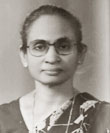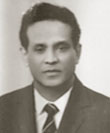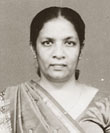History and the School of Physiotherapy and Occupational Therapy
Occupational Therapy was introduced to Sri Lanka after the Second World War in 1940s. The First Sri Lankan Occupational Therapist, Mr. D. J. Athukorele was trained in the United Kingdom and appointed to the Mental Hospital Angoda in 1952. Since then, several Occupational Therapists who were trained overseas were appointed to various facilities in the country including Anti-tuberculosis campaign, Leprosy campaign, and the Orthopedic section of the General Hospital Colombo which is the National Hospital of Sri Lanka today.
Since the inception of the profession, it was felt that there was a need to train more Occupational Therapists locally. To meet the requirement, the department of Health Services appointed a special committee in 1954 to establish Occupational Therapy training in Sri Lanka. WHO representative, Consultant Miss. Fern from the United Kingdom was involved in the development of the training course. Initially plan was to conduct a three year diploma course affiliated to medical faculty, university of Colombo.
However, in 1973 a committee chaired by Dr. L. P.D. Gunawardhana decided to implement a two year course at the School of Physiotherapy, General Hospital, Colombo, followed by one year internship in various government hospitals. Consequently, Occupational Therapy training was commenced at the School of Physiotherapy in 1976. Since then, the name of the school was changed to the School of Physiotherapy and Occupational Therapy. The management of the school is come under the Deputy director General (Education, Teaching and Research) and the Director National Hospital of Sri Lanka. The National Hospital of Sri Lanka has become the premier teaching facility for clinical placements and practicals for the OT training program.
The first Principal of the School of Physiotherapy and Occupational Therapy was Mrs. Thera Fernando who was from the Physiotherapy back ground. Initially, Miss O. Senarathne and Mr. P. W. Vidanagamage, two Occupational Therapists were sent to the United Kingdom to follow a six month teacher training program. On their return, they were appointed as tutors to the School of Physiotherapy and Occupational Therapy. Later Mr. Vidanagamage became the principal of the School of Physiotherapy and Occupational Therapy and he was the first Occupational Therapist who held this post. Mrs. S. C. A.N. Samaranayake was the second Occupational Therapist who became the principal of the school. Contribution of Mr. S. Ranasinghe to the Occupational therapy education from the early 1980s is also commendable.

Mrs T. Fernando

Mr.P. W. Vidanagamage

Mrs. S. C. A. N. Samaranayake
The first batch of six Occupational Therapists graduated in 1979, and since then there has been regular influx of Occupational Therapists to the job market on an annual basis. Today, 105 Occupational Therapists work all over the country in government hospitals and 15 work in Army, Navy and Air force hospitals. Some of them work in private sector and overseas as well. Currently, twenty 20 students are undergoing their training.
The School of Physiotherapy and Occupational Therapy is the only institute which trains Occupational Therapists in Sri Lanka. The course is conducted in English medium. A diploma certificate is awarded after two year academic training and one year successful work experience in a hospital. In 2002, the World Federation of Occupational Therapists (WFOT) which is the international professional body of Occupational Therapists, awarded full membership to the Society of Sri Lankan Occupational Therapists. In addition, individual memberships were also given as the WFOT recognized that the Occupational Therapy course conducted in Sri Lanka meets the International standards.
Under the “Mahinda Chintana†program, numbers of intake of student was increased. To accommodate the increased student population, the National hospital gave the fullest support by expanding facilities to Health Education Bureau, Family Health Bureau and the 1st floor at Public Health complex building, Narahenpita. However, administration and practical component are still carried out at the School of Physiotherapy and Occupational Therapy.

In 1976

In 2007
School of Physiotherapy and Occupational Therapy, No119, E. W. Perera Mawatha, Colombo 10.

Physiotherapy given to the patients
How to obtain the services?
Patients can get the service of the Physiotherapy and Occupational Therapy through the relevant Clinics, and Patient care services.







